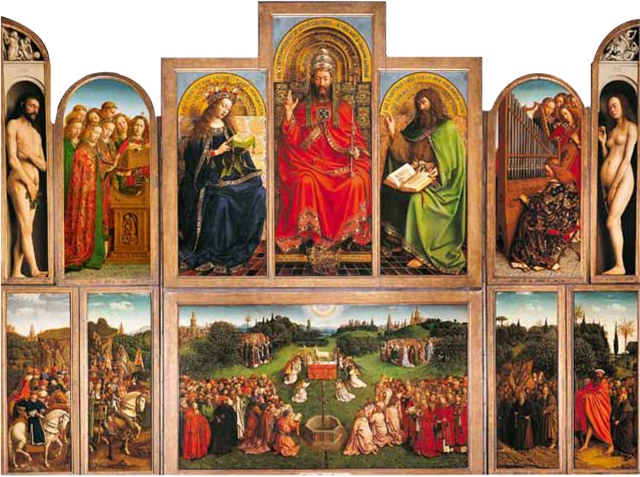My Favourite Painting: Rupert Sheldrake
Rupert Sheldrake chooses his favourite painting for Country Life.


The Adoration of the Lamb (lower middle panel of The Ghent Altarpiece), 1432, by Jan van Eyck (died 1441), Cathedral of St Bavo, Ghent, Belgium. Bridgeman Images.
Rupert Sheldrake says: 'I was completely entranced by this altarpiece when I visited it in the cathedral in Ghent. I love its combination of vividness, clarity, colour, beauty and mystery, especially in the Adoration of the Mystic Lamb, with its two sources of light, natural on the right and spiritual in the centre. All the details are exquisite; each panel is a masterpiece.'
Rupert Sheldrake is a biologist. His latest book, The Science Delusion, is reviewed on page 82
Art critic John McEwen comments: 'Artists know best about art, and the late Patrick Procktor always urged those visiting the Low Countries to take The Masters of Past Time, Dutch and Flemish Painting from van Eyck to Rembrandt by another painter, Eugene Fromentin (1820–76). ‘Have I given you an idea of it?’ Fromentin asks (after six pages of detailed and ecstatic description of the legendary altarpiece, this spring of ‘pure inspiration from which the vast movement of northern art arose’). ‘Not at all. The mind could ponder before it forever, and dream of it forever without coming to the bottom of what it expresses or what it evokes.’
Hubert van Eyck (died 1426) began the 12-panel work, and his younger and more famous brother, Jan, a diplomat as well as Court painter to the Duke of Burgundy, completed it by adding the lower section, including the climactic centrepiece. The ‘great multitude’ (John, vii, 9) surrounds ‘the Lamb of God’ (Jesus as heralded by John the Baptist) in the fields of Paradise. On the left, those who pre-dated Jesus are represented by prophets (including Virgil in white) and patriarchs; on the right, the Apostles and other members of the Church. In the distance are the steeples of the New Jerusalem.
The altarpiece has been described as ‘the most frequently stolen artwork in history’. Six panels, pawned in 1815, were even briefly in London. Reassembled, it was later seized by Hitler and hidden in a salt mine. That it is back in one piece in its original church is a miracle in itself.'
This article was first published in Country Life, March 7, 2012
Sign up for the Country Life Newsletter
Exquisite houses, the beauty of Nature, and how to get the most from your life, straight to your inbox.
Country Life is unlike any other magazine: the only glossy weekly on the newsstand and the only magazine that has been guest-edited by HRH The King not once, but twice. It is a celebration of modern rural life and all its diverse joys and pleasures — that was first published in Queen Victoria's Diamond Jubilee year. Our eclectic mixture of witty and informative content — from the most up-to-date property news and commentary and a coveted glimpse inside some of the UK's best houses and gardens, to gardening, the arts and interior design, written by experts in their field — still cannot be found in print or online, anywhere else.
-
 'To exist in this world relies on the hands of others': Roger Powell and modern British bookbinding
'To exist in this world relies on the hands of others': Roger Powell and modern British bookbindingAn exhibition on the legendary bookbinder Roger Powell reveals not only his great skill, but serves to reconnect us with the joy, power and importance of real craftsmanship.
By Hussein Kesvani
-
 Spam: The tinned meaty treat that brought a taste of the ‘hot-dog life of Hollywood’ to war-weary Britain
Spam: The tinned meaty treat that brought a taste of the ‘hot-dog life of Hollywood’ to war-weary BritainCourtesy of our ‘special relationship’ with the US, Spam was a culinary phenomenon, says Mary Greene. So much so that in 1944, London’s Simpson’s, renowned for its roast beef, was offering creamed Spam casserole instead.
By Country Life
-
 My favourite painting: Allan Mallinson
My favourite painting: Allan MallinsonMilitary historian Allan Mallinson picks an image of 'faith, generosity and ultimate sacrifice'.
By Charlotte Mullins
-
 My Favourite Painting: Piet Oudolf
My Favourite Painting: Piet Oudolf'One cannot sense whether he is far out on the ocean or closer to shore, or what he may be watching or feeling in that moment as he stares towards the beach.’
By Country Life
-
 My Favourite Painting: Mary Plazas
My Favourite Painting: Mary Plazas'There is compassion, awe, humility, a knowing yet a questioning in the glistening eyes. It moves me, it inspires me beyond the need to know.’
By Country Life
-
 My favourite painting: Robert Kime
My favourite painting: Robert KimeRobert Kime shares his fondness for New Year Snow by Ravilious
By Country Life
-
 My Favourite Painting: Anna Pavord
My Favourite Painting: Anna PavordAnna Pavord chooses a picture which reminds her of where she grew up
By Country Life
-
 My favourite painting: The Duchess of Wellington
My favourite painting: The Duchess of WellingtonThe Duchess of Wellington chooses her favourite painting for Country Life.
By Country Life
-
 My favourite painting: Maureen Lipman
My favourite painting: Maureen LipmanMaureen Lipman chooses her favourite painting for Country Life.
By Country Life
-
 My favourite painting: Jacqueline Wilson
My favourite painting: Jacqueline Wilson'I looked at this painting and decided to write about a Victorian circus girl one day'
By Country Life